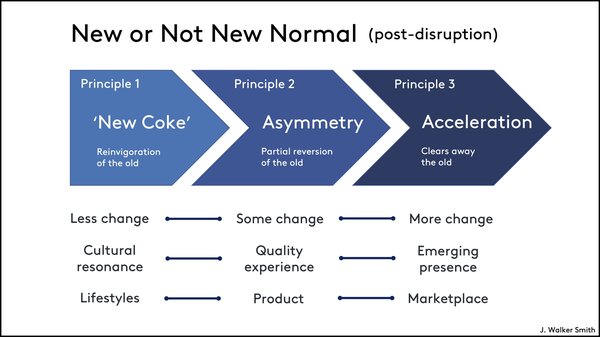Disruptive events always feel momentous and world-changing in the heat of the moment. It feels like everything is of consequence and nothing will ever be the same. But of course, it never works out like that. A few things change, some for the better and some for the worse, but most things stay the same. We look back later and much of what we thought would change has been forgotten like a New Year’s resolution. Which is why older executives can settle into the cynical view that all dreams are pipe dreams. Too often they’ve seen too much change too little.
But change following a disruption is not all or nothing. Nor is it entirely unpredictable. Disruptions are more common than we remember. Just since the turn of this century, we’ve been through three large disruptions and a handful of smaller ones. So, there is a body of experience to draw on that reveals a few rough regularities to the turmoil of marketplace upheavals. The new and the not new that follow disruptions are what this thought piece is about.
Past experience recommends three principles to use when assessing whether the so-called normal that follows a disruption will be new or not new. These principles lie along a continuum from nothing new to something new to all new. They have granular relevance for brands no less than macro relevance for categories and markets. And they define a sequence of gates through which any change must pass to be lasting and far-reaching.
The first of these is the ‘new Coke’ principle. Oftentimes, if not most times, the new makes no headway because the threat of change reinvigorates the old. The second of these is the asymmetry principle. Change necessitated by exigent circumstances will revert, but not entirely. Some change finds a toehold and progresses from there. The third of these is the acceleration principle. Big disruptions punish inefficiencies and clear away aging conventions, thereby enabling emerging trends to become mainstream.
Cultural Resonance, Asymmetry And Acceleration
New Coke is a principle about cultural resonance, and thus it is connected to lifestyles. Asymmetry is a principle about a quality experience, and thus it is connected to the product or service itself. Acceleration is a principle about building upon an emerging presence, and thus it is connected to marketplace conditions that combine to create a window of opportunity. All three implicate innovation in one way or another.
This graphic illustrates the ways in which these three principles come together. In future thought pieces on Branding Strategy Insider, I will look at specific instances or implications of these principles for the marketplace ahead.

It is worth remembering that during a disruption people want life to go back to normal. People never aspire to a new normal. They lament the loss of their old lives. People are anxious about what’s been taken away. They are not anxious to leap headfirst into the unknown. They want what they remember not something unfamiliar and uncertain.
Sometimes, we mistake the new normal for the things necessary to enable people to return to their old lives. For example, tighter security at airports and buildings was put in place after 9/11. Once past that security perimeter people feel safe and secure enough to get back to business as usual. People have accommodated the inconvenience of extra security in order to resume life as they knew it before.
What’s often forgotten is that normal life is framed and supported by institutional structures and marketplace constraints. Normal life takes place within that context. Sometimes the structures and constraints have to be modified or augmented, but the purpose of doing so is always to get back to normal.
This is not to say that under normal circumstances life doesn’t change or that during a disruption people want to go back to a life that is frozen in time. Change is a normal part of life. Disruptions are not. People want to get back to the routine of normal change.
But sometimes change is the legacy of disruptions. The commercial imperative is to figure out when this is likely to happen and what will change. Experience shows that people embrace change caused by disruptions when it resonates with their cultural values and lifestyles, when it measures up to their expectations about quality, and when it comes into full flower from a bud that was greening on the vine already.
At The Blake Project we are helping clients from around the world, in all stages of development, redefine and articulate what makes them competitive at critical moments of change through online strategy workshops. Please email us for more.
Branding Strategy Insider is a service of The Blake Project: A strategic brand consultancy specializing in Brand Research, Brand Strategy, Brand Growth and Brand Education




